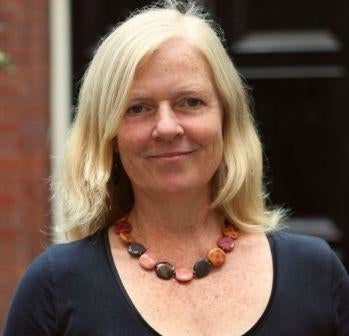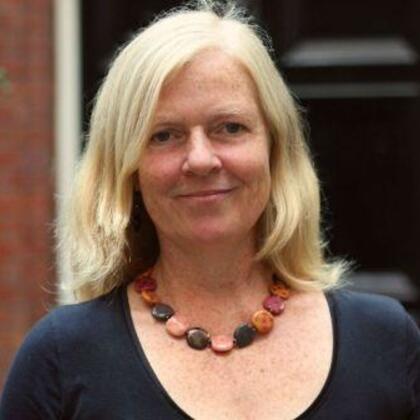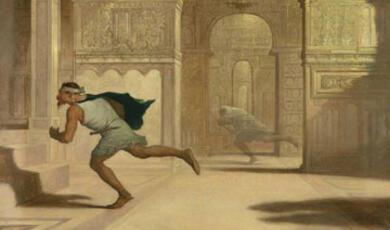What is Reading?
Share
- Details
- Transcript
- Audio
- Downloads
- Extra Reading
Neuroscience is beginning to explore what happens when we read by monitoring the areas of the brain that are stimulated while we read. Do these findings matter to the Humanities? Is there neurological evidence that the brain responds differently to ‘good’ and ‘bad’ writing? How we read clichés will be examined, as well as what the experience of re-reading tells us about reading first time round?
The current series of free public lectures is The Mysteries of Writing Novels and Poems, which take place between October 2014 and May 2015.
Download Transcript
1 October 2013
What Is Reading
Professor Belinda Jack
This is the first of six lectures which I’ve entitled ‘The Mysteries of Reading and Writing’. Tonight I’d like to open the subject up by asking a series of questions and suggesting possible answers to some of them. The answers to other questions will emerge during the course of later lectures. Or at least that’s the plan.
We take reading for granted. Once we’ve gained basic literacy our competence increases with practice and we don’t think much about it until we attempt to help someone else to learn to read. Then we’re struck by what a long and difficult process learning to read is.
And indeed how difficult it is to define. In France, in Burgundy, this summer I was struck by a sign directing people to a ‘Station de lecture du paysage’ – A Post for Reading the Landscape:
Reading is also a very complex and in some ways mysterious business.
I’d like to tell a little story to illustrate this. Imagine two young Greek boys, playing in the attic of a house in rural Greece. They come across an old chest, and in it, a letter. They persuade each other that it includes instructions as to where to find valuables hidden during the Second World War. One, let’s say Dimitris, has learnt to read but doesn’t know the local dialect in which the letter is written. The other, let’s say Gregoris, is illiterate, but is familiar with the local dialect. Dimitris gazes frustratedly at the words on the page while Gregoris asks impatiently what the letter says. Dimitris starts to ‘sound out’ the words and Gregoris encourages him occasionally correcting a slight mis-pronunciation. When Dimitris reaches the end of the letter, Gregoris is able to translate its contents into Modern Greek and they are then both aware of what the letter says.
Now, who has ‘read’ the letter? It can’t be Gregoris, as he is illiterate. Not can it be Dimitris as he doesn’t know the local dialect. So we have to conclude that the reading process has been shared and collaborative.
Reading isn’t simply about ‘sounding out the letters’. Nor can we do it without a certain oral competence in the language we’re reading.
Reading is specific to the human species, like speech, but reading doesn’t follow, or at least not directly, from innate capabilities which are activated simply by spending time with written material. With rare exceptions children learn to speak by being exposed to a linguistic environment and being encouraged into linguistic exchanges. They learn to talk according to a developmental scheme which is both genetically programmed and geared to the properties of each particular mother tongue.
But reading, as opposed to speaking, has to be learnt ‘formally’. It has to be ‘taught’ and assimilated, either in childhood or later. Without the pedagogy children remain illiterate. It is a tragedy that there are some 774 million, roughly 20% of the global adult population, illiterate people in the world [UNESCO 2013]. I say ‘a tragedy’ because I believe that reading greatly extends our understanding of the world and of ourselves.
That reading has to be taught formally has sometimes been denied, at least in fiction.
Edgar Rice Burroughs, in Tarzan, King of the Jungle tells of the young savage child finding a reading primer in the cabin abandoned by an explorer – his father. He does his utmost to make sense of what he calls the ‘little insects’, the letters, recognising their recurrence and the combinations in which they appear. He teaches himself to read.
In Marcel Pagnol’s La Gloire de mon père (My Father’s Glory) Pagnol explains how he taught himself, aged just four, to read. He was often left by his mother at the back of the classroom when his mother went shopping. He’d play with a toy and watch his father admiringly. His father assumed that he was amusing himself quietly and paying no attention to his lessons. Here’s a clip from the film:
La Gloire de mon père
Reading is the result of a patient apprenticeship guided by patient teachers. And it’s a complex process. It begins with learning how to make sense of words, then sentences, and finally what we might call the ‘global meaning’ of a text. The apprentice reader has to understand that a text is not simply a juxtaposition of sentences. Rather there are ‘befores’ and ‘afters’, and there are relations of cause and effect, or finality, between two events. Without necessarily learning formal grammar, the learner-reader of fiction has to understand that a character first introduced as Catherine, is the same character referred to later on by the pronoun ‘she’, or the character who re-appears as a definite article, followed by a noun, qualified by adjectives, ‘the pretty little girl’; ‘Catherine’, ‘she’, and ‘the pretty little girl’ are all the same ‘character’. The more one thinks about reading the more remarkable it is that it’s a skill that most of us are fortunate enough to have learnt. Because language is a tricky and slippery business.
Language is always in danger of ambiguous meaning. Take a recipe, a piece of writing designed to be clear. If the instructions that are given are not clear then the dish may be a disaster. Language intended to be unambiguous can fail.
Linguisticians enjoy representing language diagrammatically. This joke can be explained as two comparative diagrams. Here’s the cartoon:
S = subject, NP = noun phrase, Pro = pronoun, Aux = auxiliary verb (not main verb), V = verb (main verb), VP = verb phrase; DC = dependent clause, det = determinant, Adj = adjective
In terms of statistical likelihood the man has, presumably, never heard of a nose ring, hence his misunderstanding.
A good deal of our understanding of language is a matter of what we might call ‘common sense’. Linguisticians would appeal to statistical likelihoods. If someone says, ‘The master chef brought venison and tortoise/taught us to cook’, do we understand that he brought both venison and ‘tortoise’ or that he brought ‘venison’ and ‘taught us’ to cook? The latter seems more likely.
Signage is also designed to be unambiguous: HEAVY PLANT CROSSING
DIVERSION:
YouTube video of April 1st prank: DOGS MUST BE CARRIED ON THE ESCALATOR
These are fairly basic examples of ambiguous language which most of us would, nevertheless, have little difficulty understanding as intended by the sign-writers.
But if basic instructions, designed to be clear and unambiguous, are nevertheless subject to misunderstanding, then how do we make sense of idioms, metaphor and figurative language or all manner of other aspects of rhetoric – all those devices and techniques that make for effective use of language?
As a native speaker of a language we don’t read a plethora of expressions as ‘literal’. The phrase ‘as bold as brass’, for example, is applied to someone with the courage of their convictions, is outspoken about them, brazen.We understand the ‘bold’ bit, but, one might ask, what does this have to do with ‘brass’? As a non-native speaker you might look ‘brass’ up in a dictionary, wondering whether it has meanings other than the alloy of copper and zinc. If it were a fairly big dictionary you might well find an explanation of the phrase ‘bold as brass’, but in many instances there would be no account of the origin of the phrase. It is likely that a certain Mr Brass Crosby accounts for the phrase. He was a London magistrate and sympathetic to the general view that parliamentary proceedings should be made available to the public. At the time – circa 1770 – this was against the law. But a London printer thought fit to test the legislation and published a pamphlet including a report on some parliamentary debates. He was quickly arrested and brought before the magistrate, Brass Crosby, who was also Lord Mayor of London at the time – so all this is close to home. In line with public opinion, Crosby let the printer off. Crosby was then immediately arrested for treason and imprisoned. The public outcry was on such a scale that the authorities thought it wisest to release him and he walked free. He became something of a local hero and his brave stand against authority was widely reported and discussed. Hence, ‘as bold as brass’. Crosby, incidentally, has been described – rightly or wrongly – as the Julian Assange of 1771. ‘Bold as brass’: here the words are full of history and story. But there’s a danger that we no longer read the words. We simply understand the phrase to mean ‘brazen’ - all the life in it is lost. Common idiomatic phrases, however rich their origins, become clichés.
Now the origin of the word is intriguing. It’s a French word. In printing, a cliché was a printing plate cast from movable type. When letters were set one at a time, it made sense to cast a phrase used repeatedly, as a single slug of metal. ‘Cliché’ came to mean such a ready-made phrase.… . Its origins are mid-nineteenth century when the printing industry and the press, and literacy, all expanded very rapidly. This is also the moment of ascent of the novel. Poetry and theatre, sermons and histories started to lose out. And popular novels were often accused of using clichéd plots.
This is a Punch cartoon from the almanac of 1885:
So a cliché is a commonly used phrase. So why does it carry a derogatory connotation? ‘Mere cliché’, ‘that’s a cliché’: these are expressions of suspicion. My feeling is that cliché is closely associated with verbicide, a word first coined by Oliver Wendell in The Autocrat of the Breakfast-Table (1858), and popularized by C.S.Lewis. Of course words can’t be killed but they can be made moribund. And one responsibility borne by the creative writer is to revivify moribund language or, as the French poet Stéphane Mallarmé put it, ‘to purify the sense of the words of the tribe’. A good many poets, rather than shunning clichés, seek to strip them of their familiarity and re-present them to their readers in all their freshness and, often, curiousness.
Dylan Thomas’s poem ‘Fern Hill’ (1945) seduced me as a child. As a teenager I was given tape recordings of Thomas reading his own work and the hoarse yet melodious voice further added to my wonder at his language. I enjoyed the mysterious magic of the language – and the world it conjured up. I wasn’t aware of his delight in internal half rhyme and full rhyme as well as end rhyme. Thomas was very conscious of the impact of spoken or intoned verse and explored the potentialities of sound and rhythm, in a manner reminiscent of Gerard Manley Hopkins (en.wikipedia.org).
Two of the lines of ‘Fern Hill’, which is a poem that celebrates childhood experience in all its immediacy and rawness, are: ‘And once below a time I lordly had the trees and leaves/ Trail with daisies and barley’. The rhythms and music of Thomas’s poetry, and the things – the trees, the leaves, the daisies and barley - cast a powerful spell on me. I loved the title ‘Under Milk Wood’. But it was only later that I realised that Thomas’s conjuring with language was full of guile.
I’d like you to hear Thomas reading some of the poem:
One might not immediately think of aural experience having an influence on reading, but having heard Thomas reading ‘Fern Hill’ I can’t read the poem without hearing his voice and intonation.
‘Once below a time’ suggests a time out of time, what I like to think of as ‘chron-illogical’ as opposed to ‘chrono-logical’ time. There’s something else going on, not unlike subliminal marketing. What Thomas has done is to take one of the most powerful clichés of childhood, the phrase ‘Once upon a time’ and substituted the preposition ‘upon’ with something akin to its inverse, ‘below’. A whole lot of things are happening at once. We sense the comfort of the familiar, childish opening of the children’s story, at the same time as recognising that the experience that is being described belonged to a different dimension of time, a privileged space enjoyed only by children. Reflecting on the prepositions, the cliché comes alive again. Instead of seeing the words ‘Once upon time’ and simply allowing these to suggest that a story is about to begin, we see the words and wonder as to the meaning of the clichéd phrase. How can something be ‘upon’ a time? According to the OED the origins of the idiom go back to before 1380. It had become well-established as an opening to a children’s story by 1600. Thomas revivifies clichés that have very long histories indeed.
I was also struck by Thomas’s radio play, Under Milk Wood (1954). The title is intriguing in part because of the use of the preposition. As I child I knew of a village near to where I lived called ‘Shipton-under-Wychwood’. ‘Milk Wood’ didn’t seem unfamiliar as a place-name and ‘milk’ had more comforting overtones than ‘wych’, however it was spelt. Place names that are made up of two names joined by a preposition (‘on’, ‘by’, ‘over’ and so on) are common and the origin of these names goes back a very long way. But Thomas’s title is made up of a missing name, then preposition, then name. So this suggests a Wholly Anonymous Locality - Under-Milkwood’. This introduces an atmosphere of mystery, of secrecy, of something sinister, perhaps. All this sets the scene for a play about people’s dreams and their sub-conscious lives. And the prefix ‘sub’ (in ‘subconscious’ means ‘under’).]
Thomas has adjusted other techniques to bring them back to life. Some way into the play we learn that everything is taking place in asmall fictional Welsh fishing village called Llareggub – is there a Welsh speaker here who can correct my pronunciation? Llareggub is ‘bugger all’ backwards. Samuel Butler had played the same sort of game in 1872 when he published his anonymous Erewhon (an anagram of ‘nowhere’). But Thomas has revivified the idea by forming it out of a mild indecency, which is, humorously, Welsh in its orthography – at least to the non-Welsh-speaking ear!
Much of what strikes us most forcibly when we read is language that counters acts of verbicide. And that it is this kind of language that moves us most deeply is substantiated by research in neuroscience. A friend of mine in the field explained that they are still very much in the foothills when it comes to understanding what goes on when we read complex language but some of the initial research is intriguing. . Scientists have known about ‘classical’ language regions in the brain like Broca’s area and Wernicke’s, and that these are stimulated when the brain interprets new words. But it is now clear that stories activate other areas of the brain in addition. Words like ‘lavender’, ‘cinnamon’ and ‘soap’ activate both language-processing areas of the brain and also those that respond to smells. Significant work has now been done on how the brain responds to metaphor and this ties in with my theories about cliché. Participants in these studies read clichéd metaphors like ‘a rough day’ and these stimulated only the language-sensitive parts of the brain. The metaphor ‘a liquid chocolate voice’, on the other hand, stimulated areas of the brain concerned both with language - and with taste. ‘A leathery face’ stimulated the sensory cortex. And an exciting, vivid action plot stimulates parts of the brain that coordinate movement. Powerful language, it seems, stimulates us in ways that are similar to real life. To use Coleridge’s intriguing phrase – we suspend disbelief. This isn’t quite the same as believing… . You could liken this to what happens when we watch a conjuring trick. Take the one where the woman is apparently sawn in half.
Do we really believe that this act of violence is being committed? Surely if we did we would rush onto the stage and intervene. Is the spectacle any less beguiling if we know how it’s done?
In both cases we suspend disbelief and this allows us to experience a spectacle or the events of a novel, as though they were real life. In the case of the novel, we step inside someone else’s body, mind and soul. We can lead multiple lives.
One of the most moving descriptions of its liberating force is in Alan Bennett’s wonderful novella, The Uncommon Reader (2007). The Queen, our Queen Elizabeth II, has suddenly become an avid reader having happened upon the mobile library that parks at the back of the Palace to service her staff’s reading needs. The household fear that her reading may have a de-stabilizing force and her Private Secretary questions her as to why ‘briefing’ isn’t sufficient. We live in a world of briefings, soundbites, summaries, and short-cuts. Bennett’s Queen remonstrates with her Secretary, saying, ‘Briefing is not reading. In fact it is the antithesis of reading. Briefing is terse, factual and to the point. Reading is untidy, discursive and perpetually inviting. Briefing closes down a subject, reading opens it up.’
This evening we considered some aspects of the process of reading, its complexities and imponderables. In my next lecture I’d like to consider the reader, as opposed to reading. We’ll be exploring a range of images of readers and asking what they tell us about perceptions of reading. Here are a couple of tasters:
Rembrandt’s The Scholar, 1631, and Théodore Roussel, The Reading Girl,1886-7 (in the Tate Gallery if anyone has the time and desire to go and see it – in the flesh, as it were!).
I’ll be talking about these paintings in my next lecture. To end today I simply like to you to consider how very different these two paintings are. Yet they are both paintings of readers. What do they tell us about reading?
© Professor Belinda Jack 2013
Part of:
This event was on Tue, 01 Oct 2013
Support Gresham
Gresham College has offered an outstanding education to the public free of charge for over 400 years. Today, Gresham plays an important role in fostering a love of learning and a greater understanding of ourselves and the world around us. Your donation will help to widen our reach and to broaden our audience, allowing more people to benefit from a high-quality education from some of the brightest minds.


 Login
Login







